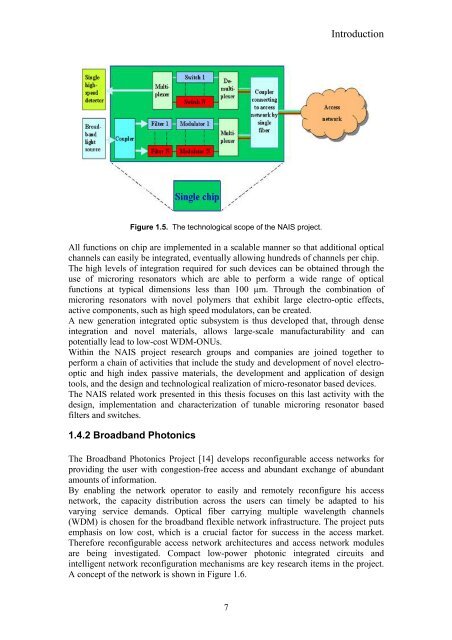Edwin Jan Klein - Universiteit Twente
Edwin Jan Klein - Universiteit Twente
Edwin Jan Klein - Universiteit Twente
You also want an ePaper? Increase the reach of your titles
YUMPU automatically turns print PDFs into web optimized ePapers that Google loves.
Figure 1.5. The technological scope of the NAIS project.<br />
7<br />
Introduction<br />
All functions on chip are implemented in a scalable manner so that additional optical<br />
channels can easily be integrated, eventually allowing hundreds of channels per chip.<br />
The high levels of integration required for such devices can be obtained through the<br />
use of microring resonators which are able to perform a wide range of optical<br />
functions at typical dimensions less than 100 µm. Through the combination of<br />
microring resonators with novel polymers that exhibit large electro-optic effects,<br />
active components, such as high speed modulators, can be created.<br />
A new generation integrated optic subsystem is thus developed that, through dense<br />
integration and novel materials, allows large-scale manufacturability and can<br />
potentially lead to low-cost WDM-ONUs.<br />
Within the NAIS project research groups and companies are joined together to<br />
perform a chain of activities that include the study and development of novel electrooptic<br />
and high index passive materials, the development and application of design<br />
tools, and the design and technological realization of micro-resonator based devices.<br />
The NAIS related work presented in this thesis focuses on this last activity with the<br />
design, implementation and characterization of tunable microring resonator based<br />
filters and switches.<br />
1.4.2 Broadband Photonics<br />
The Broadband Photonics Project [14] develops reconfigurable access networks for<br />
providing the user with congestion-free access and abundant exchange of abundant<br />
amounts of information.<br />
By enabling the network operator to easily and remotely reconfigure his access<br />
network, the capacity distribution across the users can timely be adapted to his<br />
varying service demands. Optical fiber carrying multiple wavelength channels<br />
(WDM) is chosen for the broadband flexible network infrastructure. The project puts<br />
emphasis on low cost, which is a crucial factor for success in the access market.<br />
Therefore reconfigurable access network architectures and access network modules<br />
are being investigated. Compact low-power photonic integrated circuits and<br />
intelligent network reconfiguration mechanisms are key research items in the project.<br />
A concept of the network is shown in Figure 1.6.















